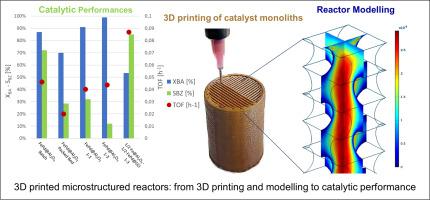Sustainable Materials and Technologies ( IF 8.6 ) Pub Date : 2021-08-06 , DOI: 10.1016/j.susmat.2021.e00329 Clément Jacquot 1, 2 , Vesna Middelkoop 2 , Angela Köckritz 3 , Andrej Pohar 4 , Regina Bienert 3 , Suela Kellici 5 , Ioan-Alexandru Bărăgău 5 , Baldassarre Venezia 6 , Asterios Gavriilidis 6 , Blaz Likozar 4 , Andrew M. Beale 1, 7

|
In this work, novel, patterned monolithic reactors were devised to explore more efficient routes for reactant conversion in order to investigate their potential to replace the packed bed and batch reactors conventionally employed in chemical industries. Well-defined bimetallic formulations were developed to substitute platinum group metals and critical raw materials such as palladium and cobalt, at least in part, by less active, but more sustainable and cost-effective metals such as earth-abundant iron. FePd and FeCo based monoliths were 3D printed and stacked in a continuous flow tubular reactor for testing the selective oxidation of benzyl alcohol (BA) into benzaldehyde (BZ) under mild conditions (80–100 °C and atmospheric pressure). The novel monolithic reactors were evaluated against current state-of-the-art reactor technologies, conventional packed bed and batch reactors. The FeCo- and FePd-Al2O3-supported monolithic catalyst beds showed higher conversion and TOF than their packed bed counterparts under the same operating conditions, revealing the impact of the novel design on both regular geometry and composition. What is of particular interest in the catalytic measurements shown is that the combined stacking of two monoliths in a flow reactor, Al2O3-supported Fe and GO-supported FePd catalysts, can significantly improve the performance with an increase in TOF of up to 90% in comparison to their FePd analogues. Mathematical modelling was used to obtain additional insights into the physical and chemical processes governing the rate of BA conversion. It was found that due to the flow regime inside the microchannels, an axial dispersion model was appropriate, which allowed for mapping the concentration profiles of the reactants and products within the respective monolith geometries.
中文翻译:

用于在连续多相流中将苯甲醇有氧选择性氧化成苯甲醛的 3D 打印催化反应器
在这项工作中,设计了新颖的、有图案的整体反应器来探索更有效的反应物转化途径,以研究它们取代化学工业中常规使用的填充床和间歇反应器的潜力。开发了明确定义的双金属配方,以至少部分地用活性较低但更具可持续性和成本效益的金属(如地球丰富的铁)替代铂族金属和关键原材料(如钯和钴)。FePd 和 FeCo 基整料被 3D 打印并堆叠在连续流动的管式反应器中,用于测试在温和条件下(80-100°C 和大气压)苯甲醇 (BA) 选择性氧化成苯甲醛 (BZ)。针对当前最先进的反应器技术对新型整体反应器进行了评估,传统的填充床和间歇式反应器。在相同的操作条件下,FeCo 和 FePd-Al2O3 负载的整体催化剂床显示出比填充床更高的转化率和 TOF,揭示了新颖设计对规则几何形状和组成的影响。所显示的催化测量中特别令人感兴趣的是流动反应器中两个整体式的组合堆叠,Al2 O 3负载的 Fe 和 GO 负载的 FePd 催化剂可以显着提高性能,与它们的 FePd 类似物相比,TOF 增加高达 90%。数学建模用于获得对控制 BA 转化率的物理和化学过程的更多见解。发现由于微通道内部的流动状态,轴向分散模型是合适的,它允许绘制相应整体几何形状内的反应物和产物的浓度分布图。









































 京公网安备 11010802027423号
京公网安备 11010802027423号